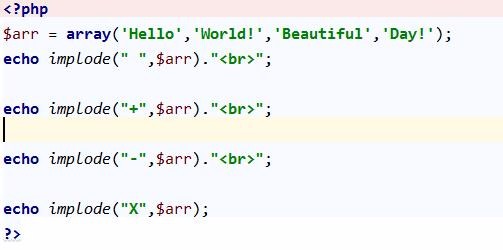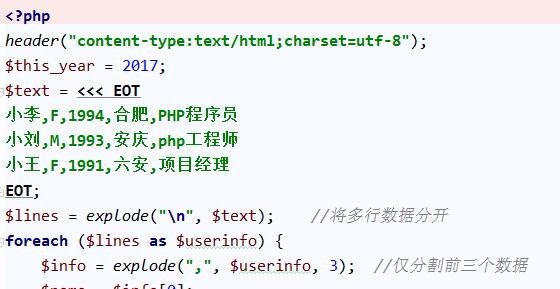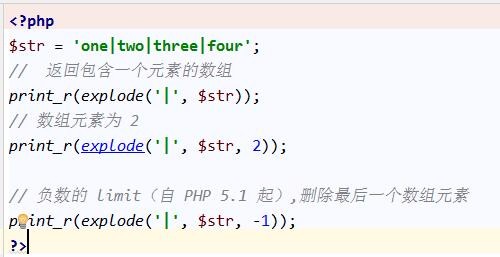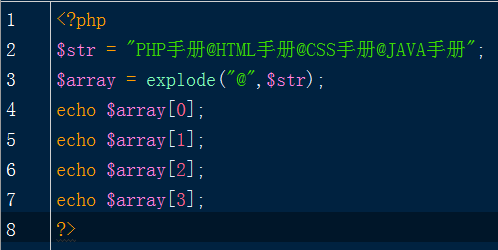10 recommended articles about explode
Split the string The splitting of the string is achieved through the explode() function. The explode() function splits a string according to the specified rules, and the return value is an array. The grammar format is as follows: the parameter list of the Explode (SEPAROR, String, Limit) function is as follows: paraparator's necessary parameters, specify the segmentation identifier. string required parameter, specifies the string to be split limit optional parameter, specifies the number of array elements returned Note: if separator is an empty string (" "), explode() will return false; if separator contains The value cannot be found in string, then the explode() function will return an array containing a single element of string. If the limit parameter is set, the returned array contains at most limit elements, and the last element will contain the remainder of the string; if the limit parameter is a negative number, all but the last -lim
1 are returned. Detailed introduction about compound words

##Introduction: Splitting strings The splitting of strings is through Implemented by explode() function. The explode() function splits a string according to the specified rules, and the return value is an array. The syntax format is as follows: The parameter list of the explode(separator, string, limit) function is as follows: Parameters string required parameter, specify the string to be split limit optional...
2. 10 recommended articles about the php explode() function

Introduction: The example in this article describes how PHP obtains the number of days in the current month and the date array based on the year and month. Share it with everyone for your reference, the details are as follows: function get_day( $date ) { $tem = explode('-' , $date); //
##3.Recommended 10 articles about the php in_array() function

4.
Some usage summary of php implode() function

5.
##Introduction: In PHP, the explode() function splits a string into an array. Its return value is an array composed of strings, each element of which is a substring separated by separator as a boundary point. This article summarizes some articles about the php explode() function. I hope it will be helpful for everyone to learn the php explode() function. 6.
The difference between the usage of php implode() function and explode() function
Introduction: The explode() function in PHP is: use one string to split another string and return an array composed of strings. The implode() function returns a string composed of array elements. These two functions are the conversion functions between strings and arrays.
8. How to use the php explode() function
##Introduction: To split a string in PHP, we can use the function explode(). Usually in development projects, we want to view various parts of the string submitted by users through forms or other methods for easy classification. Storage and use. For example, looking at words in a sentence, or splitting a URL or email address into its component parts. At this time we can use the explode() function. This article will introduce how to use the php explode() function
9.php explode() function example detailed explanation 
Introduction: What does the php explode() function do? The php explode() function is: use one string to split another string and return an array composed of strings. Now that we understand what the explode() function does, let’s take a look at the syntax:
10.PHP split and synthesize string function analysis
Introduction: String splitting is achieved through the explode() function. The explode() function splits a string according to the specified rules, and the return value is an array. The syntax format is as follows:
[Related Q&A recommendations]: javascript - Why can't explode separate spaces?
javascript - Why can't explode separate spaces?
php When there are too many function parameters, what is the efficiency if we use string instead?
php parsing the content paging problem in Kindeditor
Does php mysql select support the explode field and then sort according to the value?
serializers - The data passed by ajax is a serialized string, why does php accept it as an array?
The above is the detailed content of 10 recommended articles about explode. For more information, please follow other related articles on the PHP Chinese website!

Hot AI Tools

Undresser.AI Undress
AI-powered app for creating realistic nude photos

AI Clothes Remover
Online AI tool for removing clothes from photos.

Undress AI Tool
Undress images for free

Clothoff.io
AI clothes remover

Video Face Swap
Swap faces in any video effortlessly with our completely free AI face swap tool!

Hot Article

Hot Tools

Notepad++7.3.1
Easy-to-use and free code editor

SublimeText3 Chinese version
Chinese version, very easy to use

Zend Studio 13.0.1
Powerful PHP integrated development environment

Dreamweaver CS6
Visual web development tools

SublimeText3 Mac version
God-level code editing software (SublimeText3)

Hot Topics
 1667
1667
 14
14
 1426
1426
 52
52
 1328
1328
 25
25
 1273
1273
 29
29
 1255
1255
 24
24
 PHP: A Key Language for Web Development
Apr 13, 2025 am 12:08 AM
PHP: A Key Language for Web Development
Apr 13, 2025 am 12:08 AM
PHP is a scripting language widely used on the server side, especially suitable for web development. 1.PHP can embed HTML, process HTTP requests and responses, and supports a variety of databases. 2.PHP is used to generate dynamic web content, process form data, access databases, etc., with strong community support and open source resources. 3. PHP is an interpreted language, and the execution process includes lexical analysis, grammatical analysis, compilation and execution. 4.PHP can be combined with MySQL for advanced applications such as user registration systems. 5. When debugging PHP, you can use functions such as error_reporting() and var_dump(). 6. Optimize PHP code to use caching mechanisms, optimize database queries and use built-in functions. 7
 PHP and Python: Comparing Two Popular Programming Languages
Apr 14, 2025 am 12:13 AM
PHP and Python: Comparing Two Popular Programming Languages
Apr 14, 2025 am 12:13 AM
PHP and Python each have their own advantages, and choose according to project requirements. 1.PHP is suitable for web development, especially for rapid development and maintenance of websites. 2. Python is suitable for data science, machine learning and artificial intelligence, with concise syntax and suitable for beginners.
 PHP vs. Python: Understanding the Differences
Apr 11, 2025 am 12:15 AM
PHP vs. Python: Understanding the Differences
Apr 11, 2025 am 12:15 AM
PHP and Python each have their own advantages, and the choice should be based on project requirements. 1.PHP is suitable for web development, with simple syntax and high execution efficiency. 2. Python is suitable for data science and machine learning, with concise syntax and rich libraries.
 PHP in Action: Real-World Examples and Applications
Apr 14, 2025 am 12:19 AM
PHP in Action: Real-World Examples and Applications
Apr 14, 2025 am 12:19 AM
PHP is widely used in e-commerce, content management systems and API development. 1) E-commerce: used for shopping cart function and payment processing. 2) Content management system: used for dynamic content generation and user management. 3) API development: used for RESTful API development and API security. Through performance optimization and best practices, the efficiency and maintainability of PHP applications are improved.
 The Enduring Relevance of PHP: Is It Still Alive?
Apr 14, 2025 am 12:12 AM
The Enduring Relevance of PHP: Is It Still Alive?
Apr 14, 2025 am 12:12 AM
PHP is still dynamic and still occupies an important position in the field of modern programming. 1) PHP's simplicity and powerful community support make it widely used in web development; 2) Its flexibility and stability make it outstanding in handling web forms, database operations and file processing; 3) PHP is constantly evolving and optimizing, suitable for beginners and experienced developers.
 PHP vs. Other Languages: A Comparison
Apr 13, 2025 am 12:19 AM
PHP vs. Other Languages: A Comparison
Apr 13, 2025 am 12:19 AM
PHP is suitable for web development, especially in rapid development and processing dynamic content, but is not good at data science and enterprise-level applications. Compared with Python, PHP has more advantages in web development, but is not as good as Python in the field of data science; compared with Java, PHP performs worse in enterprise-level applications, but is more flexible in web development; compared with JavaScript, PHP is more concise in back-end development, but is not as good as JavaScript in front-end development.
 PHP and Python: Different Paradigms Explained
Apr 18, 2025 am 12:26 AM
PHP and Python: Different Paradigms Explained
Apr 18, 2025 am 12:26 AM
PHP is mainly procedural programming, but also supports object-oriented programming (OOP); Python supports a variety of paradigms, including OOP, functional and procedural programming. PHP is suitable for web development, and Python is suitable for a variety of applications such as data analysis and machine learning.
 PHP and Python: Code Examples and Comparison
Apr 15, 2025 am 12:07 AM
PHP and Python: Code Examples and Comparison
Apr 15, 2025 am 12:07 AM
PHP and Python have their own advantages and disadvantages, and the choice depends on project needs and personal preferences. 1.PHP is suitable for rapid development and maintenance of large-scale web applications. 2. Python dominates the field of data science and machine learning.




